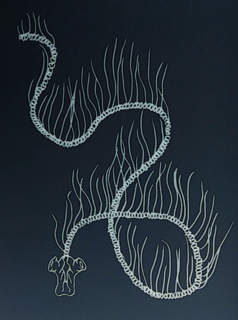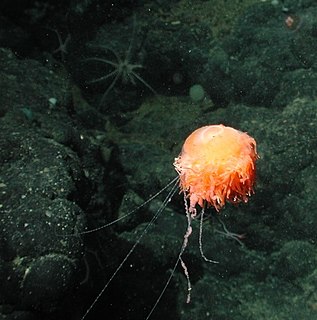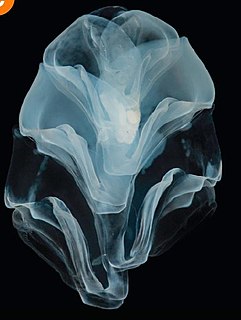
Siphonophorae is an order of Hydrozoans, a class of marine organisms belonging to the phylum Cnidaria. According to the World Register of Marine Species, the order contains 175 species.

A salp or salpa is a barrel-shaped, planktic tunicate. It moves by contracting, thereby pumping water through its gelatinous body, one of the most efficient examples of jet propulsion in the animal kingdom. The salp strains the pumped water through its internal feeding filters, feeding on phytoplankton.

Lottia is a genus of sea snails, specifically true limpets, marine gastropod mollusks in the subfamily Lottiinae of the family Lottiidae, one of the families of true limpets.

María de los Ángeles Alvariño González, known as Ángeles Alvariño, was a Spanish fishery research biologist and oceanographer globally recognized as an authority in plankton biology. She was the first woman ever appointed as scientist aboard any British or Spanish exploration ships. She discovered 22 new species of marine animals and published over a hundred scientific books, chapters and articles. In her late career she studied the history of early marine scientific exploration.

Emarginula is a genus of small keyhole limpets, marine gastropod molluscs in the family Fissurellidae.

Acanthochitona is a genus of chitons in the family Acanthochitonidae, of worldwide distribution.

Notoplax is a genus of chitons in the family Acanthochitonidae.

Muricodrupa is a genus of sea snails, marine gastropod mollusks in the subfamily Ergalataxinae of the family Muricidae, the murex snails or rock snails.

Cryptoplax is a genus of polyplacophoran molluscs. The genus consists of the following living species:

Agalmatidae, or Agalmidae, is a family of siphonophores.

Prayidae is a family of marine invertebrates in the order Siphonophora. They are colonial, and the colonies can superficially resemble jellyfish; although they appear to be a single organism, each specimen is actually a colony of Siphonophora.

The Abylidae are a family of marine invertebrates in the order Siphonophora. They are colonial, but the colonies can superficially resemble jellyfish; although they appear to be a single organism, each specimen is actually a colony of Siphonophora.

Alveopora is a genus of colonial stony corals in the family Acroporidae. Members of this genus are native to the Indo-Pacific region and are often found on reef slopes in turbid water. They are generally uncommon.

Muggiaea is a genus of siphonophores in the family Diphyidae. Members of this family are colonial siphonophores with two nectophores arranged one behind the other, but in the genus Muggiaea, the posterior nectophore is absent. The anterior one has a complete dorsal ridge. The somatocyst is very close to the nectosac wall.

Rhodaliidae is a family of siphonophores. In Japanese they are called ヒノマルクラゲ.
Halistemma is a genus of cnidarians belonging to the family Agalmatidae.

Hippopodius is a genus of cnidarians belonging to the family Hippopodiidae.
Diphyes is a genus of hydrozoans belonging to the family Diphyidae.
Chelophyes is a genus of hydrozoans belonging to the family Diphyidae.
















